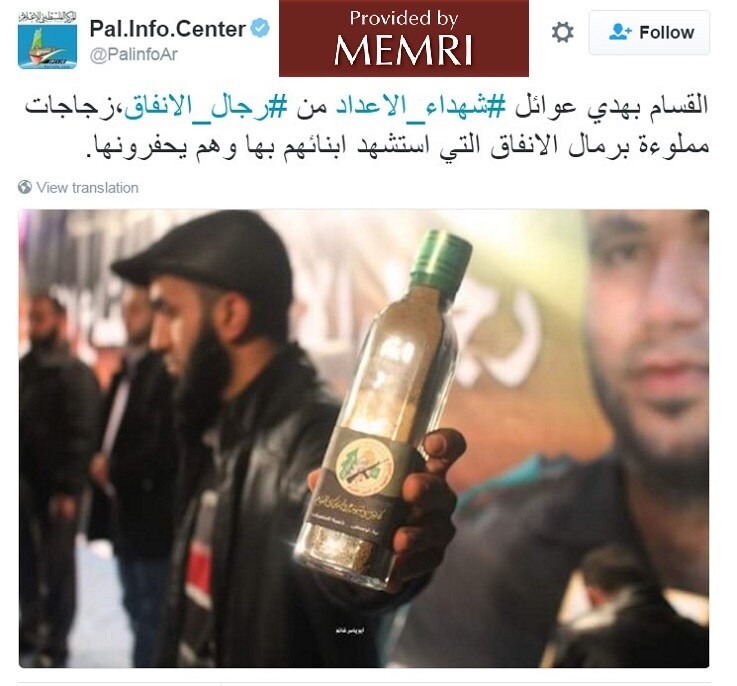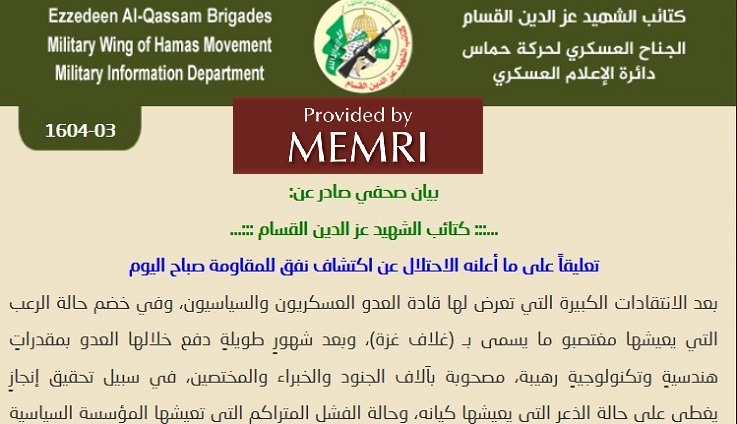by MEMRI
Recently, the issue of Hamas's tunnels is again making headlines, following reports of tunnel collapses in the Gaza Strip in which Hamas activists died; Israel's finding of tunnels excavated from the Gaza Strip into Israel near Kerem Shalom; and reports on the defection to Israel of Sami Al-'Atawneh, the head of the tunnel network of Hamas's 'Izz Al-Din Al-Qassam Brigades, east of Jabalia.
The excavation of the
attack tunnels at the Israel-Gaza border began shortly after the end of the
summer 2014 Israel-Gaza conflict, as part of Hamas's renewal of its military
preparations in advance of another conflict with Israel. (See MEMRI
Special Dispatch No. 5863, Hamas' Construction Of Gaza Tunnels Continues, October 23, 2014).
Reports
on the subject of tunnels have been published by Hamas media outlets, and Hamas
officials have made many references to the importance of the tunnels,
particularly in light of the deaths of many Hamas activists in collapses. Hamas
officials warned repeatedly that the movement is continuing to excavate, even
during the tahdiya (calm), in preparation for the next conflict with Israel,
and that the tunnel that has been exposed by Israel was a mere "drop in
the ocean." Likewise, an ethos of sacrifice and martyrdom has been built
up around those who died in tunnel collapses, who have been dubbed "the
martyrs of the preparations."
As
Hamas leaders were issuing these declarations about preparations for the next
round of conflict with Israel and about the importance of building the tunnels
for this purpose, at the same time, grasping the incendiary potential of such
declarations, movement officials are sending reassuring messages that they are
not aiming at an escalation and that the tunnels are strictly defensive. This,
particularly in light of international criticism
of Hamas's ongoing tunnel activity, particularly that of UN Secretary-General
Ban Ki-moon, who expressed alarm at Hamas's intention "to continue
building tunnels and firing rockets at Israel" and added that "such
statements and actions" put the reconstruction of Gaza at risk.[1]
Hamas's backtracking on its statements may also be due to concern about a
possible escalation vis-a-vis Israel at an inconvenient time for the movement.
It
should be noted that Hamas has yet to rebuild the Gaza Strip since the summer
2014 conflict, and that it is unclear whether it has fully restored its military
infrastructure. Furthermore, it seems that the movement does not have the
substantial political and financial backing it will need in a conflict, and
this for the following reasons. First, the Muslim Brotherhood (MB) regime has
been ousted in Egypt, and the current regime, led by 'Abd Al-Fattah Al-Sisi, continues
to be openly hostile to Hamas, except for various security understandings with
it. Second, Hamas has been removed from the pro-Iran axis, because of its
support for the Syrian rebels, and Iranian funding for its military wing has
been substantially cut back. Third, Hamas's sponsors, Qatar and Turkey, have
grown closer to Saudi Arabia, which considers the MB (considered to be Hamas's
parent movement) a terrorist organization, as recently noted by Saudi Foreign Minister
'Adel Al-Jubeir.[2] As a result, Hamas has
distanced itself from the MB, and has said that it does not take orders from it
and that the ties between the two movements are purely ideological, not
political.[3]
Hamas constructs three types of tunnels in the Gaza Strip:
1. Attack tunnels that start in Gaza and approach the
Israeli border. They are intended for launching attacks, including kidnappings,
inside Israel, in settlements or army bases near the border.
2. The smuggling tunnels on the Gaza-Egypt border, often
referred to as "Gaza's lifeline." Used to bring in goods and weapons,
they have been less active since the removal of the MB regime in Egypt,
especially since the current regime regularly floods them with seawater.
3. The "Gaza underground" – a network of tunnels
running beneath Gaza City, used for hiding Hamas members, for storing weapons
and equipment, for communications among Hamas members, and for providing secure
passage within the city. Rockets are launched from some of them, and some also
serve as observation posts.
The military role of the
tunnels has been discussed by writers and commentators on Hamas websites. Columnist
Iyad Al-Qara, on Hamas's Filastin website, wrote: "There is a tunnel unit
in Gaza, alongside other units such as the rocket unit and the frogmen. There
is also a new unit established recently to hold future kidnapped [Israeli]
prisoners. Currently, this unit is holding missing Israelis who are in Gaza.[4]
Dr. 'Adnan Abu 'Amer, a commentator on Hamas websites,
wrote about the tunnels: "Hamas fighters in black uniforms patrol the Gaza
tunnels, [armed] with automatic rifles. They feel at home [deep] beneath the
[Gaza] Strip, in the network of tunnels that they dug and built with their own
hands. They live there in safety and security, and some of the tunnels are
[even] tall enough to let them walk upright... The tunnels branch out in
several directions." [5]
Soon
after the 2014 Gaza conflict, Hamas officials announced numerous times that the
movement was excavating attack tunnels in the Gaza Strip. In September 2014,
Hamas official Mahmoud Al-Zahhar announced that Hamas had begun rebuilding and
developing the tunnels.[6]
A month later, in October, the Hamas mouthpiece Al-Risalah wrote about
the restarting of work on attack tunnels in Gaza, noting that 'Izz Al-Din
Al-Qassam Brigades members were digging around the clock, dozens of meters
below the surface.[7]

Photo of tunnel, Al-Risalah, Gaza, October 19, 2014.
An August 2015 Al-Qassam Brigades video, translated and published by MEMRI TV, shows members of Hamas's tunnel unit training in the tunnels for activity against Israel.[8]
In late December 2015, Palestinian Legislative Council
(PLC) member from Hamas Mushir Al-Masri declared that "tens of thousands
of Al-Qassam fighters are working day and night, aboveground and underground, preparing
for the next battle." He added, "This is the [kind of] tahdiya
Hamas understands – preparing with all [our] might."[9]
Several weeks later, Hamas members again began mentioning
the tunnels frequently, particularly following a number of tunnel collapses in
which many Al-Qassam Brigades operatives were killed. The most serious of these
collapses, on January 27, 2016, killed seven Al-Qassam Brigades operatives.
Hamas officials explained that they had sacrificed their lives while preparing
for the next conflict. Since then, several more tunnels have collapsed,
claiming the lives of more Hamas members.[10]

The seven Al-Qassam Brigades members killed in the January 2016 tunnel collapse (Palinfo.com, January 28, 2016)

Al-Qassam brigades presents families with bottles of sand from the tunnels in which their relatives were killed (Twitter.com/PalinfoAr, February 5, 2016)
In his January 29, 2016 Friday sermon at a Gaza mosque, Isma'il
Haniya, deputy director of Hamas's political bureau, said: "Gaza bids
farewell to the martyrs of the preparations for any conflict with the Israeli
occupation that may come. Gaza has constructed twice as many tunnels as there
were in Vietnam.[11]
The Al-Qassam Brigades have dug tunnels around Gaza in order to defend the people and
liberate Al-Aqsa and the holy places." He added: "This weapon, the
weapon of tunnels, played a prominent role in achieving our victory. From these
tunnels emerged the jihad fighters who carried out the Nahal Oz operation.[12]
From these tunnels, the jihad fighters captured [Israeli soldier] Oron Shaul. From
these tunnels, they fought the [Israeli] soldiers at close range, and emerged
behind enemy lines. Because of these tunnels, our military spokesman could say:
'The jihad fighters carried out their mission and returned to their bases safe
and sound'... East of Gaza, there are heroes underground, digging through rock
and constructing tunnels. West of Gaza, there are heroes who test-fire rockets
every day – All these [activities] are preparations – underground in the
tunnels, in the air by means of missiles, at sea, and everywhere. This constant
preparation is for the sake of Palestine, for Jerusalem and Al-Aqsa, and for
the Al-Quds Intifada."[13]
Haniya's statements about the tunnels prompted UN
Secretary-General Ban Ki-moon to express alarm at Hamas's intention "to
continue building tunnels and firing rockets at Israel. Such statements and
actions," he added, "put at risk reconstruction, humanitarian and
development efforts by the international community and Palestinian and Israeli
authorities."[14]
Hamas, however, rejected Ban's words, accusing him of pro-Israel bias; on
January 31, it said: "We reject these statements about the tunnels of the
resistance, which are defensive and aimed at protecting the Gaza Strip."[15]
The same day, Al-Qassam Brigades spokesman Abu 'Ubaida said: "We do not
seek war, but we will continue to prepare for conflict."[16]
Contradictory messages regarding the tunnels were also
evident in statements by top Hamas official Mahmoud Al-Zahhar. On February 3, Al-Zahhar boasted that the tunnels
had reached Israel, but two hours later backtracked, claiming that his
statements had been wrongly reported and stressing, "The tunnels are
defensive and are aimed at meeting an Israeli attack."[17]
A few weeks later, on February 24, Al-Zahhar reiterated that the tunnels were
defensive, adding that they had at one point reached Israel (implying that now
they do not): "The [Hamas] movement does not seek a new war with Israel,
and the network of tunnels that it is digging, some of which once reached
Israel, are defensive. We do not want a clash with Israel, but if it attacks us
will be obliged to defend ourselves..."[18]
On April 15, Haniya once again mentioned the tunnels, in his
Friday sermon in front of the Red Cross offices in Gaza during a Hamas rally in
honor of Palestinian Prisoners Day, which falls two days later. He clarified
that the resistance would not rest until all the Palestinian prisoners were
released from Israeli prisons, and added that this message from Hamas to the
Palestinian prisoners was "sealed in blood, triggers, guns, tunnels, and
trenches."[19]
Furthermore, in response to Israel's exposure of a tunnel
near its border in April 2016, the Al-Qassam Brigades said in an official
communique: "The campaign of preparation and deployment continues in all areas.
What the enemy has announced [i.e. the exposure of the tunnel] is but a mere
drop in the ocean of what the resistance has prepared to defend its people and
liberate its holy sites, its land, and its prisoners.'[20]

The Al-Qassam Brigades communique (Alqassam.ps/arabic, April 18, 2016)Hamas has not yet rebuilt the Gaza strip,
Tunnel
Diggers Revered As Jihad Fighters And As Martyrs
An
ethos of courage, sacrifice and martyrdom has developed around Al-Qassam members
killed in the tunnels. Tunnel construction is described as jihad waged proudly
by these fighters, with the aim of reaching Paradise. The men's parents express
their pride in them and praise their longing for martyrdom, and the men who are
killed receive heroes' funerals that are attended by large crowds and by Hamas
leaders.
Referring to the seven militants killed in the late January
2016 tunnel collapse, Hamas political bureau head Khaled Mash'al eulogized
them: "Hamas's preparations for the next conflict will continue. The death
of these heroes was part of the popular struggle and the unceasing preparations
to resist the occupation. [They are] the pride of people and the nation."[21]
Al-Qassam spokesman Abu 'Ubaida said: "The heroism of the tunnel
[activists] is like the heroism of those carrying out attacks in the West Bank.
We will act to free the prisoners, and we have the means to compel Israel to
release them."[22]

The funeral of the Al-Qassam Brigades members killed in the late January 2016 tunnel collapse (Image: Palinfo.com, January 30) 2016)
This ethos of heroism and martyrdom was also evident in
reports and articles published by the Hamas mouthpiece Al-Risalah on
February 1, 2016. Al-Risalah reporter Maha Shahwan wrote about one of
the seven: "The [wedding] ululations still echo in the home of the martyr,
Al-Qassam Brigades [fighter] Ja'far Hamadah. [Only] two months ago he wed his wife
Du'a, but the black-eyed [virgins of Paradise] soon snatched him up to become a
martyr."
Another Al-Risalah reporter, Muhammad Al-'Arabid,
wrote about another of the dead men: "The martyr Thabet Al-Rifi told his
father on numerous occasions, 'I hope to give my life for Allah.' His father
expressed pride in his son's death, saying: 'We will teach our children to love
the homeland and give their lives for Allah. We will not give up a single grain
of Palestinian soil."
Al-Risalah editor Wisam 'Afifa wrote: "We
shall tell the coming generations about this phenomenon, unique in the history
of Palestinian resistance. We shall explain to them that every inch of Gazan
land is sacred because it bears traces of the tunnel[-diggers], who sent up
their prayers and uttered the names of Allah deep beneath the earth. At the end
of the tunnel, their eyes spied a ray of sunlight – a sign that a mission of
jihad in Palestine was carried out, from which a martyr would emerge."[23]
Al-Risalah columnist Shayma Marzouq wrote: "It
is as if we dug a tunnel to heaven, in order to emerge from it as
martyrs." Journalist Ghasan Al-Shami was even more effusive: "The men
of preparation and jihad missions, the Palestinian resistance [fighters], the
keepers of the gate, get little sleep at night, [for] arduous and glorious
missions await them. They spend long hours [in the tunnels], digging tirelessly
into the solid rock with their bare hands and teeth, for days and months. They
know the correct path, [with] its hardships and brambles – it is the path of
jihad and martyrdom." [24]
Endnotes:
[1]
Un.org, January 30, 2016.
[2]
'Okaz (Saudi Arabia), April 11, 2016.
[3]
See, for example, Mahmoud Al-Zahhar in Al-Sharq
(Qatar), March 29, 2016; and Sami Abu Zuhri in Alarabiya.net, March 22, 2016.
[4]
Felesteen.ps, January 28, 2016.
[5]
Felesteen.ps, February 1, 2016.
[6] Al-Ayyam (Palestinian
Authority), September 20, 2014.
[7]
See MEMRI Special Dispatch No. 5863, Hamas'
Construction Of Gaza Tunnels Continues, October 23, 2015.
[8]
See MEMRI TV Clip No. 5058, Video
Clip Presents Footage of Hamas's Tunnel Digging Unit, August 26, 2015; On
tunnels dug by the Islamic Jihad group, see
www.youtube.com/watch?v=EnBSWCugLog
.
[9]
Amad.ps, December 30, 2015.
[10]
Thus, for example, on February 28, 2016, a tunnel collapsed injuring five
members of the 'Izz Al-Din Al-Qassam brigades. See alquds.com, February 28,
2016. Another Al-Qassam member, 'Abd Al-Salam Al-Batniji was killed in tunnel
operations on March14, 2016. See palinfo.com, March 16, 2016. A tunnel also
collapsed on the Gaza-Egypt border on April 10, killing several people. See
alhaya.ps, April 10, 2016.
[11]
A reference to the tens of thousands of miles of Cu Chi Tunnels dug by the Viet
Cong during the war.
[12]
On July 28, 2015, several Al-Qassam
gunmen used a tunnel to breach the
Israeli border and infiltrate an army base near Kibbutz Nahal Oz, killing five
soldiers.
[13]
Palinfo.com, January 29, 2016. See MEMRI TV Clip No. 5293, Hamas PM Haniya in Friday
Sermon: We Are Digging Tunnels East of Gaza, January 29, 2016.
[14]
Un.org, January 30, 2016.
[15]
Aljazeera.net, January 31, 2016.
[16]
Palinfo.com, January 31, 2016.
[17]
Alquds.com, February 3, 2016.
[18]
Al-Ayyam (PA), February 26, 2016.
[19]
Youtube.com/watch?v=NH59A52bnyM,
April 15, 2016.
[20]
Alqassam.ps/arabic, April 18, 2016.
[21]
Palinfo.com, January 30, 2016.
[22]
Palinfo.com, January 31, 2016.
[23]
Al-Risalah (Gaza), February 1, 2016.
[24]
Al-Risalah (Gaza), February 1, 2016.
MEMRI
Source: http://www.memri.org/report/en/0/0/0/0/0/0/9140.htm
Copyright - Original materials copyright (c) by the authors.
No comments:
Post a Comment